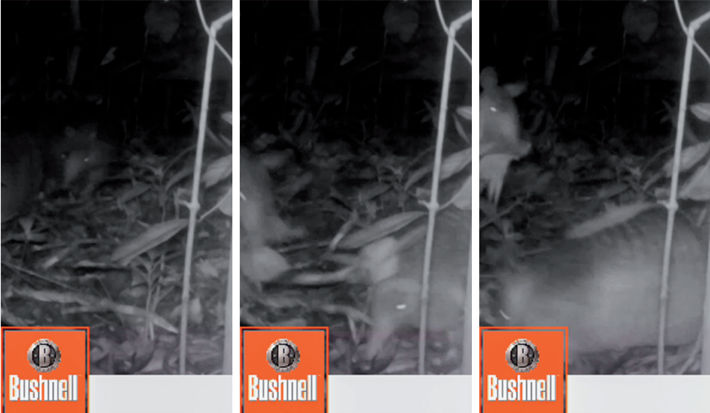Fight club: Dasypus novemcinctus agonistic behavior in an island area of the Brazilian Atlantic Forest
DOI:
https://doi.org/10.31687/saremNMS.20.0.35Resumen
Dasypus novemcinctus has a large geographical distribution and can occur in a wide range of habitat types. There are few studies about their ecology within the Neotropical region. Studying the mammal community using camera traps in an island of Rio de Janeiro state, Brazil, we recorded an agonistic behavior between two individuals of D. novemcinctus. This kind of social interaction is part of the species’ behavioral repertoire, but this is the first record in the wild in the Neotropical region. The use of camera traps in field work enables observing species behaviors, allowing the establishment of appropriate conservation strategies.
Citas
Abba, A. M., & M. Superina. 2010. The 2009/2010 Armadillo Red List Assessment. Edentata 11:135–184.
Alexy, K. J., K. J. Brunjes, J. W. Gassett, & K. V. Miller. 2003. Gopher Tortoise Burrow Use. Wildlife Society Bulletin 31:1240–1243.
Arteaga, M. C., J. Gasca-Pineda, R. Bello-Bedoy, L. E. Eguiarte, & R. A. Medellin. 2020. Conservation genetics, demographic history, and climatic distribution of the nine-banded armadillo (Dasypus novemcinctus): An analysis of its mitochondrial lineages. Conservation Genetics in Mammals: Integrative Research Using Novel Approaches (J. Ortega & J. Maldonado, eds.). Springer International Publishing.
Bridges, A. A., & A. J. Noss. 2011. Behavior and Activity Patterns. Pp. 57–68, in: Camera Traps in Animal Ecology – Methods and Analyses. Springer.
Caravaggi, A., et al. 2017. A review of camera trapping for conservation behaviour research. Remote Sensing in Ecology and Conservation 3:109–122.
Clark, W. K. 1951. Ecological life history of the armadillo in the eastern Edwards Plateau Region. American Midland Naturalist 46:337–358.
Costa, F. R., S. C. B. Pedrini, & P. S. Rosa. 2011. Registro do repertório comportamental associado às interações sociais em Dasypus novemcinctus Linnaeus, 1758 (Mammalia: Cingulata: Dasypodidae). Revista Brasileira de Zoociências 13:179–184.
Crawford, J. C., R. D. Bluett, & E. M. Schauber. 2015. Conspecific aggression by beavers (Castor canadensis) in the Sangamon river basin in central Illinois: Correlates with habitat, age, sex and season. American Midland Naturalist 173:145–155.
Feijó, A., & P. Cordeiro-Estrela. 2016. Taxonomic revision of the Dasypus kappleri complex, with revalidations of Dasypus pastasae (Thomas, 1901) and Dasypus beniensis Lönnberg, 1942 (Cingulata, Dasypodidae). Zootaxa 4170:271–297.
Fitch, H. S., P. Goodrum, & C. Newman. 1952. The armadillo in the southeastern United States. Journal of Mammalogy 33:21–37.
Greene, H. W. 1989. Agonistic Behavior by Three-toed Sloths, Bradypus variegatus. Biotropica 21:369–372.
Korytko, A. I., & S. H. Vessey. 1991. Agonistic and spacing behaviour in white-footed mice, Peromyscus leucopus. Animal Behaviour 42:913–919.
Kreutz, K., F. Fischer, & K. E. Linsenmair. 2009. Observations of lntraspecific Aggression in Giant Anteaters (Myrmecophaga tridactyla). Edentata 10:6–7.
Layne, J. N., & D. Glover. 1977. Home range of the armadillo in Florida. Journal of Mammalogy 58:411–413.
Loughry, W. J., & C. M. McDonough. 1998. Comparisons between nine-banded armadillo (Dasypus novemcinctus) populations in Brazil and the United States. Revista de Biología Tropical 46:1173–1183.
Loughry, W. J., C. M. McDonough, & A. M. Abba [online]. 2014. Dasypus novemcinctus (Nine-banded armadillo). Dasypus novemcinctus. The IUCN Red List of Threatened Species. <https://www.iucnredlist.org/species/6290/47440785> (15 April 2020).
Magnusson, W. E., et al. 2005. RAPELD: a modification of the Gentry method for biodiversity surveys in long-term ecological research sites. Biota Neotropica 5:19–24.
McDonough, C. M. 1994. Determinants of aggression in nine-banded armadillos. Journal of Mammalogy 75:189–198.
McDonough, C. M. 1997. Pairing behavior of the nine-banded armadillo (Dasypus novemcinctus). American Midland Naturalist 138:290–298.
McDonough, C. M., & W. J. Loughry. 2005. Impacts of land management practices on a population of nine-banded armadillos in northern Florida. Wildlife Society Bulletin 33:1198–1209.
McDonough, C. M., & W. J. Loughry. 2006. Behavioral ecology of armadillos. Pp. 281–293, in: The Biology of the Xenarthra. University Press of Florida.
Silva, K. F. M., J. F. Costa, T. C. da S. Anacleto, & T. P. de C. Timo [online]. 2015. Avaliação do risco de extinção de Dasypus novemcinctus Linnaeus, 1758 no Brasil. Processo de avaliação do risco de extinção da fauna brasileira. ICMBio. <https://www.icmbio.gov.br/portal/faunabrasileira/estado-de-conservacao/7106-mamiferos-dasypus-novemcintus-tatu-galinha> (6 April 2020).
Superina, M., N. Pagnutti, & A. M. Abba. 2014. What do we know about armadillos? An analysis of four centuries of knowledge about a group of South American mammals, with emphasis on their conservation. Mammal Review 44:69–80.
Taber, F. W. 1945. Contribution on the life history and ecology of the nine-banded armadillo. Journal of Mammalogy 26:211–226.
Taulman, J. F. 1994. Observations of nest construction and bathing behaviors in the nine-banded armadillo, Dasypus novemcinctus. The Southwestern Naturalist 39:378–380.
Taulman, J. F., & L. W. Robbins. 1996. Recent range expansion and distributional limits of the nine-banded armadillo (Dasypus novemcinctus) in the United States. Journal of Biogeography 23:635–648.
Taulman, J. F., & L. W. Robbins. 2014. Range expansion and distributional limits of the nine-banded armadillo in the United States: An update of Taulman & Robbins (1996). Journal of Biogeography 41:1626–1630.

Descargas
Publicado
Cómo citar
Número
Sección
Licencia
Derechos de autor 2020 Paula Diniz, Helena G. Bergallo

Esta obra está bajo una licencia internacional Creative Commons Atribución-NoComercial 4.0.

